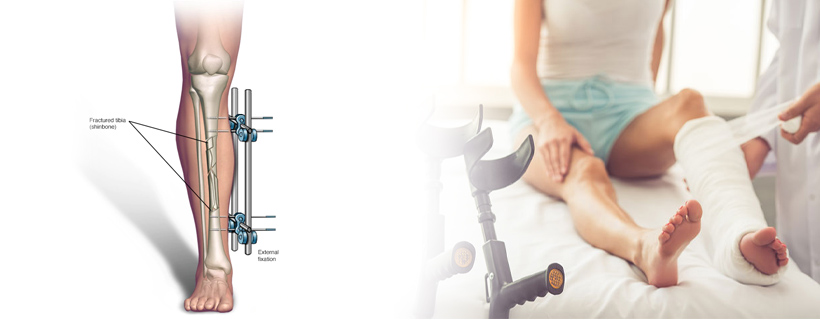
Fracture Treatment
A Fracture or popularly known as bone fracture is a medical condition in which the bone loses its continuity. This can be the result of stress or trauma injury. This damage is also possible due to the medical condition in which the bones become weaker. The weakening of bones is the result of osteoporosis, bone cancer, or osteogenesis imperfecta, etc.
DIFFERENT TYPES OF BONE FRACTURE
- Avulsion fracture
- Comminuted fracture
- Compression (crush) fracture
- Fracture dislocation
- Greenstick fracture
- Hairline fracture
- Impacted fracture
- Longitudinal fracture
- Oblique fracture
- Pathological fracture
- Spiral fracture
- Stress fracture
- Torus (buckle) fracture
- Transverse fracture
During the bone fracture treatment, the realignment of the bone is involved. It is performed to connects the ends of the bones properly. It also involves internal and external splints. If you are looking for trusted bone fracture treatment, then you Dr. Bageja is the most recommended Orthopaedic Surgeon. Prior to giving this treatment, he thoroughly examines all the reports in order to know the graveness of the problem. After consulting with his highly competent team of doctors, he starts providing the treatment with utmost accuracy. The complete treatment is provided as per the international clinical standards.
The treatment is provided at Orthopaedic Surgeon Dr. Bageja’s clinic, which is equipped with the state of the art technology & machinery. All these facilities will ensure that you get the best medical facilities from our end.
SOME OF THE MEDICAL ISSUES TO CONSIDER
The surgeon will recommend the fracture treatment on the basis of the severity of the injury and the location of the fractured bone. Some of the common types of fractures include:
Complicated Fracture: When the surrounding structures are injured along with the fractured bone, then it is considered as complicated fracture. This type of fracture may destroy the nerves, arteries and veins and it may also damage the lining of the bone.
Open fracture: When the broken bone punctures the skin of the fracture site, then it is called as open fracture.
Closed Fracture: In this type of fracture the skin remains intact and the surrounding tissue is damaged slightly.
FIRST AID WITH FRACTURES
It is important for the patient to go for good first aid care. Moving the broken bone abnormally may result in heavy bleeding and pain and sometime it may also injury the surrounding tissues. This may also cause complications in the treatment process and may also hamper the healing process later. So, before you visit the surgeon first aid care is very important. First aid for fractures involves limiting movement and immobilizing the injury. The external bleeding should be controlled immediately, especially in the case of open fracture.
Excellent first aid care of fractures is always important. Abnormal movement of the broken bones can increase pain and bleeding and cause damage of the tissues around the injury. This can lead to complications in the repair and healing of the injury later on.
Treatments for Fractures: Using Plaster of Paris is the most common method that is used in immobilizing a limb. This is actually made out of gypsum that becomes harder when used along with water. Surgery is also performed in the case of bone fracture, but it greatly depends on the severity and location of the fracture.
Treatment for Closed Fracture: In this procedure the ends of the broken bones are aligned properly and fixed in place. Bandage is used to hold the limb in place and then wet plaster is applied on it. After few months when the plaster dries, the cast is ripped into two parts and the surgeon re-bandaged the area from outside so as to allow the swelling to occur.
Treatment Open Fracture: In open fracture surgery, the site of fracture is cleaned thoroughly so as to remove the debris and dirt because chances of infection are higher with the broken bone that is exposed to open air. To set the fractured bone the surgeon fixes wires and pins through the skin above and below the fracture site and to hold these pins and wires a bar is placed outside the skin where these pins and wires are connected. When the bone heals, the surgeon removes pins.
Treatment for Long Bone Fracture: The long bones of thigh are quite difficult to keep aligned, even in adults. So, the surgeons usually utilize internal nailing to aligned them. Besides, children with long bone fracture may need traction for few days before setting the cast. When the surgeon notices that the edges of broken bone are healing, then they will immobilize the hip and leg joint with POP (Plaster of Paris). In some rare cases, the surgeon also inserts pins below and above the fracture site and connects them with external frame and they use general anesthesia to perform this surgical procedure.
Other forms of fracture treatments:The surgeons generally immobilize the bones of toes and collarbones with splint or sling instead of using plaster. In such cases, the patient needs to take complete bed rest for at least two months.


